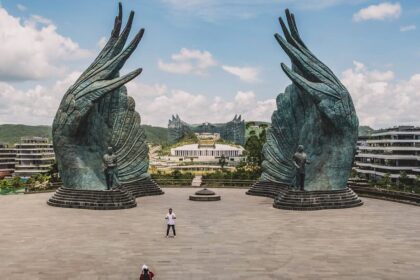The Manga That Shook Japan’s Tourism Industry
In the summer of 2025, Japan’s tourism industry—usually bustling with visitors from across Asia—has been rocked by an unexpected force: a rumor, rooted in a decades-old manga, that a catastrophic earthquake or tsunami will strike the country in July. The prediction, which has gone viral across social media and news outlets in Hong Kong, Taiwan, South Korea, and beyond, has led to a dramatic drop in travel bookings, flight cancellations, and widespread anxiety among would-be tourists. But what is the origin of this prophecy, and does it have any scientific basis?
- The Manga That Shook Japan’s Tourism Industry
- Origins: A Manga, a Dream Diary, and a Prophecy
- How the Prophecy Went Viral
- Tourism Impact: Bookings Plummet, Airlines Cut Flights
- What Does the Manga Actually Say?
- Science vs. Prophecy: Can Earthquakes Be Predicted?
- Why Do People Believe in Prophecies?
- Official Responses: Calls for Calm and Rationality
- In Summary
Origins: A Manga, a Dream Diary, and a Prophecy
The story begins with “Watashi ga Mita Mirai” (“The Future I Saw”), a manga first published in 1999 by Japanese artist Ryo Tatsuki. The manga is based on a series of dreams Tatsuki recorded in the 1980s, which she later illustrated and published as a graphic novel. Among the dreams, one cryptically predicted a “great disaster” in March 2011—a date that, in hindsight, coincided with the devastating Tohoku earthquake and tsunami that struck Japan, killing nearly 20,000 people and triggering the Fukushima nuclear disaster.
This apparent prediction catapulted Tatsuki to cult status in Japan and across East Asia. Her manga, reissued in 2021 as a “complete edition,” included a new, ominous warning: “The real catastrophe will come in July 2025.” In the updated version, Tatsuki describes a vision of a crack opening under the seabed between Japan and the Philippines, unleashing a tsunami “three times larger” than the 2011 disaster, and the ocean “boiling” off Japan’s coast. The specificity of the date—July 5, 2025—has fueled speculation and fear, especially as the manga’s previous “prediction” seemed to come true.
How the Prophecy Went Viral
While Japan is no stranger to earthquakes—sitting atop four major tectonic plates and within the seismically active “Ring of Fire”—the idea of a precisely timed disaster is new. The July 2025 prophecy gained traction thanks to several factors:
- Social Media Amplification: Influential feng shui masters and psychics in Hong Kong and mainland China began referencing the manga’s prediction in early 2025. Viral videos, hashtags like #July2025Prediction, and survival gear sales all contributed to the sense of impending doom.
- Media Coverage: News outlets across Asia reported on the prophecy, often highlighting the manga’s “track record” of predictions, including the 2011 earthquake, the deaths of Princess Diana and Freddie Mercury, and even the COVID-19 pandemic.
- Official Warnings: Around the same time, the Japanese government released a new damage-projection report for the Nankai Trough—a fault zone off Japan’s Pacific coast—raising the 30-year probability of a mega-quake from 70-80% to around 80%. While this was standard scientific risk assessment, it was misinterpreted by some as confirmation of the manga’s prophecy.
The result was a perfect storm of rumor, anxiety, and misinformation, leading to a tangible impact on travel behavior.
Tourism Impact: Bookings Plummet, Airlines Cut Flights
The effect of the prophecy on Japan’s tourism industry has been dramatic, especially in Hong Kong, Taiwan, and South Korea—key markets for Japanese tourism. According to data from Bloomberg Intelligence and ForwardKeys:
- Flight bookings from Hong Kong to Japan dropped by 50% year-on-year during the April-May spring break.
- Reservations for late June to early July 2025 plummeted by as much as 83% compared to the previous year.
- Similar declines were reported from Taiwan and South Korea, with some travel agencies seeing an 80% reduction in summer bookings.
Greater Bay Airlines, a Hong Kong-based low-cost carrier, reduced its Sendai service from four to two round trips per week and cut Tokushima flights due to stagnating reservations. Other airlines and travel agencies reported similar trends, with many travelers opting for alternative destinations such as mainland China, Australia, or Europe.
Yuen Chun-ning, executive director of Hong Kong travel agency WWPKG, explained the situation:
“The continuous dissemination of rumors has significantly dented confidence among Hong Kong travelers heading to Japan. Even with discounts and promotions, the lack of bookings is a clear indication of travelers’ unwillingness to take risks.”
Despite the panic in some markets, Japan’s overall tourism numbers remain robust. The Japan National Tourism Organization reported a record 10.5 million international visitors in the first three months of 2025, with strong growth from mainland China and other regions. However, the sharp drop in bookings from certain East Asian markets is a significant concern for local economies and the tourism sector.
What Does the Manga Actually Say?
“The Future I Saw” is not a typical disaster manga. It is a collection of 15 dreams Tatsuki recorded in 1985, illustrated and annotated with dates and cryptic messages. Some of the most notable “predictions” include:
- The 1995 Kobe earthquake
- The 2011 Tohoku earthquake and tsunami
- The deaths of Princess Diana and Freddie Mercury
- A pandemic in 2020 (interpreted as COVID-19)
The July 2025 prophecy is the most alarming: a vision of a massive undersea rupture between Japan and the Philippines, causing a tsunami and “boiling seas.” The manga’s reprint has sold nearly a million copies since 2021, and its cult status has only grown with the approach of the predicted date.
However, experts and even Tatsuki herself caution against taking these predictions literally. In a recent interview with the Mainichi Shimbun, Tatsuki said:
“It’s important not to be unnecessarily influenced… and to listen to the opinions of experts.”
Science vs. Prophecy: Can Earthquakes Be Predicted?
Japan is one of the most earthquake-prone countries in the world, but predicting the exact time, location, and magnitude of an earthquake remains scientifically impossible. The Japan Meteorological Agency (JMA), which continuously monitors seismic and volcanic activity, has repeatedly emphasized that there are no signs of an impending disaster in July 2025.
Ryoichi Nomura, director general of the JMA, addressed the rumors at a May 21 briefing:
“It is impossible to predict the exact time and location of an earthquake. We urge the public not to be swayed by disaster information that specifies a date and strongly advise against acting irrationally out of fear.”
Seismologists explain that while it is possible to estimate the probability of a major earthquake occurring in a given region over decades, pinpointing a specific day or month is beyond current scientific capability. Stewart Fishwick, professor of geophysics at the University of Leicester, told Metro.co.uk:
“Even the 80% chance in the next 30 years is at the very high end of the range of forecasts that have been made for this area—others put it at around 10-30%. The precise time, location, and magnitude of a particular earthquake cannot be predicted.”
Japan’s advanced disaster preparedness infrastructure—including a 400-kilometer tsunami wall, earthquake-resistant building codes, and high-speed trains equipped with seismic detection systems—means the country is better equipped than most to handle natural disasters. But the unpredictability of earthquakes is a fact of life in Japan, and experts stress the importance of general preparedness rather than panic over specific dates.
Why Do People Believe in Prophecies?
The power of Tatsuki’s manga lies not just in its content, but in the cultural and psychological context in which it is read. Laura Miller, professor of Japanese studies at the University of Missouri, told Newsweek:
“Divination and forecasts about the future are present in all forms of popular culture, including hundreds of other manga. Perhaps Tatsuki’s manga resonates with people outside Japan who have amorphous worries about the future, and this manga is a way to debate or focus on anxiety.”
Japan’s history of devastating earthquakes, combined with the collective trauma of the 2011 disaster, makes the population especially sensitive to warnings—however unscientific. The “prophecy effect” is amplified by social media, where rumors can spread rapidly and take on a life of their own. The phenomenon is not unique to Japan; similar waves of anxiety have been seen globally, such as the 2012 “Mayan apocalypse” scare.
Official Responses: Calls for Calm and Rationality
Japanese officials and local governors have been quick to address the rumors and urge travelers not to be swayed by unscientific predictions. Yoshihiro Murai, governor of Miyagi Prefecture—one of the regions hardest hit by the 2011 earthquake—stated at a press conference:
“It would be a major problem if the spread of unscientific rumors on social media had an effect on tourism. There is no reason to worry because Japanese are not fleeing abroad… I hope people will ignore the rumors and visit.”
Similarly, the Japan Meteorological Agency and disaster preparedness experts have reiterated that there is no scientific basis for the July 2025 prophecy. The message from authorities is clear: while it is always wise to be prepared for natural disasters in Japan, there is no reason to cancel travel plans based on rumors or fictional predictions.
In Summary
- A rumor of a catastrophic earthquake or tsunami striking Japan in July 2025, rooted in the manga “The Future I Saw” by Ryo Tatsuki, has gone viral in East Asia.
- The prophecy has led to a dramatic drop in travel bookings from Hong Kong, Taiwan, and South Korea, with some airlines cutting flights and travel agencies reporting up to 83% declines in reservations.
- The manga’s cult status is based on its apparent prediction of the 2011 Tohoku earthquake, but experts and the author herself caution against taking its visions literally.
- Japan’s government and scientific community emphasize that predicting the exact time and location of earthquakes is impossible, and there are no signs of an impending disaster in July 2025.
- Japan remains a world leader in disaster preparedness, with robust infrastructure and emergency systems in place.
- Officials urge travelers to rely on expert advice, remain calm, and not let rumors dictate their plans.












